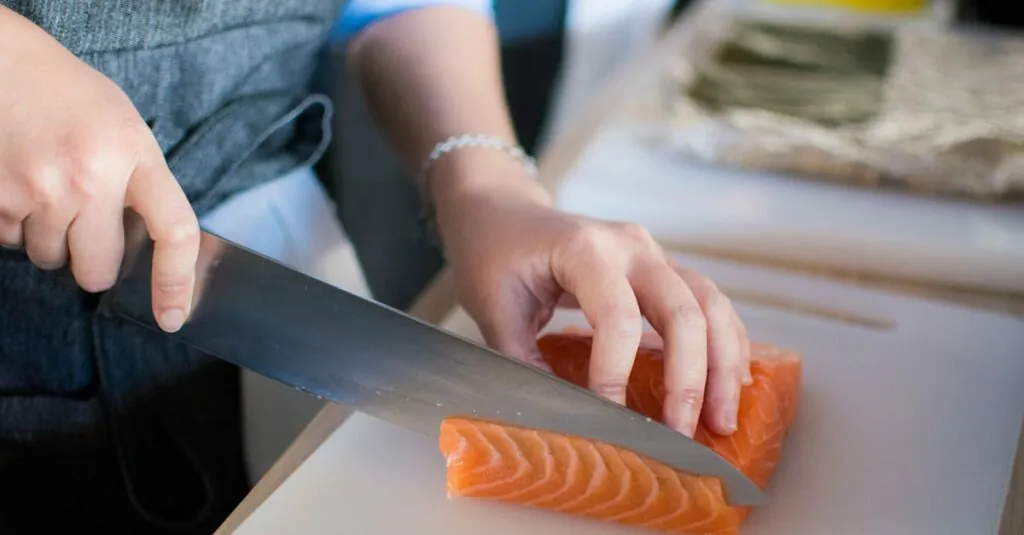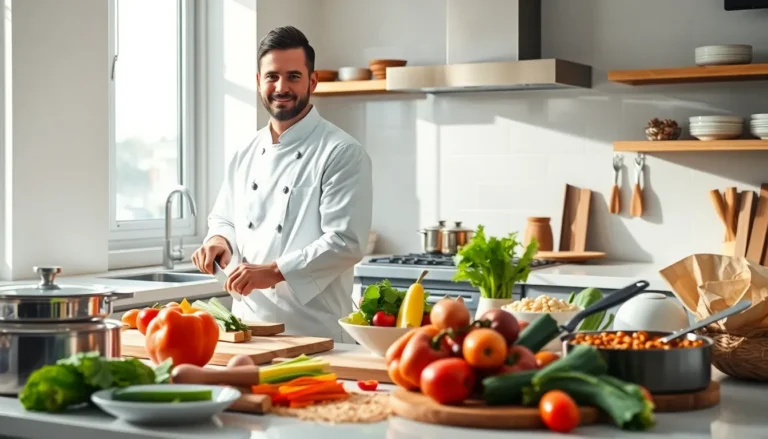Table of Contents
ToggleIn the culinary world, a chef’s best friend isn’t just a trusty apron; it’s a well-sharpened knife. Mastering knife techniques isn’t just about slicing and dicing; it’s an art form that can elevate any dish from mediocre to Michelin-star worthy. Whether it’s the perfect julienne or a delicate chiffonade, knowing how to wield a knife can make anyone feel like a kitchen ninja—minus the throwing stars and dramatic music.
Overview of Knife Techniques Cooking
Mastering knife techniques in cooking enhances culinary skills significantly. A well-sharpened knife not only provides safety but also improves efficiency. Common techniques include chopping, mincing, and julienne, each serving distinct purposes in food preparation.
Chopping involves cutting ingredients into uniform pieces, which ensures even cooking. Mince requires finely chopping ingredients like garlic or herbs to release their flavors effectively. Julienne produces thin, matchstick-like shapes ideal for garnishing or stir-frying.
Learning how to hold a knife correctly is fundamental. The pinch grip secures the blade, offering better control and precision. Finger placement also influences the performance, so proper technique reduces the risk of slips.
Practice makes perfect in mastering these skills. Regularly honing knife techniques builds confidence and speeds up food preparation. Chefs often recommend using fresh ingredients, as they respond better to different knife skills.
Each technique carries unique benefits, enhancing the final presentation and taste of dishes. For instance, a precise dice yields a uniform appearance, elevating the visual appeal of a plate. Familiarity with these techniques allows cooks to elevate their artistry in the kitchen.
Investing time in learning these knife techniques transforms cooking from a task to a refined skill. Emphasizing technique not only improves meal quality but also enriches the cooking experience.
Essential Knife Skills
Mastering knife skills significantly enhances the cooking process. A well-equipped kitchen features various knives, each serving a specific purpose.
Understanding Different Knife Types
Chef’s knives excel at versatility, ideal for chopping and slicing. Paring knives support intricate tasks, such as peeling fruits and trimming vegetables. Santoku knives feature a unique design, favoring precision for dicing and mincing. A serrated knife specializes in cutting through crusty bread or ripe tomatoes smoothly. Boning knives ensure effortless separating of meat from bones, making them essential for protein preparation. Selecting the right knife can dramatically improve efficiency and result in uniform cuts during food prep.
Proper Knife Grip and Posture
Holding a knife correctly boosts control during cutting. The pinch grip involves pinching the blade with the thumb and index finger while wrapping the remaining fingers around the handle. This grip allows for better stability and precision. Maintaining a proper posture involves standing tall with feet shoulder-width apart, ensuring balance and comfort. Elbows should remain close to the body, with the non-dominant hand guiding the food. Practicing this grip and posture minimizes slip risks and enhances cutting speed and consistency.
Basic Techniques in Knife Skills
Mastering fundamental knife skills forms the backbone of effective cooking. Each technique plays a crucial role in achieving consistent results and enhancing flavors.
Chopping and Dicing
Chopping involves cutting food into uniform pieces, facilitating even cooking. Precision in size ensures that ingredients cook at similar rates, preventing uneven textures in your dishes. Dicing typically requires cutting food into smaller, square-shaped pieces. A sharp knife enhances speed and accuracy during this process, resulting in clean cuts. For example, diced onions benefit a wide range of recipes by releasing their natural sweetness when evenly sized. Practicing chopping and dicing techniques builds confidence and refines a cook’s overall skill set.
Slicing and Julienne
Slicing creates thin, uniform pieces, often used for meats or vegetables. A steady hand supports smooth, fluid motions, contributing to an appealing presentation. The julienne technique branches into producing matchstick-shaped pieces, perfect for salads or stir-fries. This method amplifies the visual appeal of dishes while retaining the freshness and crunch of ingredients. Utilizing a well-sharpened knife enhances the efficiency of both slicing and julienne, making food prep quick and enjoyable. Regular practice of these techniques leads to greater speed and increased accuracy in the kitchen.
Advanced Knife Techniques
Mastering advanced knife techniques enhances culinary skills further. These techniques improve precision and presentation in food preparation.
Mincing and Chiffonade
Mincing involves finely chopping ingredients like garlic or herbs for maximum flavor release. This technique requires a rocking motion of the knife for consistency. Chiffonade, on the other hand, creates delicate ribbons of leafy greens or herbs. It starts with stacking and rolling the leaves before slicing them into thin strips. Both techniques elevate the visual appeal and taste of dishes, ensuring flavors meld effectively.
Filleting and Boning
Filleting refers to separating the flesh of fish from its bones, yielding clean, boneless portions. A flexible, sharp fillet knife is essential for this task, allowing for smooth cuts along the backbone. Boning focuses on removing bones from meat cuts, such as chicken or pork. Mastery of this technique reduces waste while providing clean, usable meat for recipes. Precision in both techniques enhances kitchen efficiency, builds skill, and improves overall meal preparation.
Safety Tips for Knife Techniques Cooking
Staying safe while using knives in the kitchen enhances the cooking experience. Selecting a sharp knife reduces the need for excessive force, minimizing the risk of slips and accidents. When handling knives, always cut away from the body; this prevents any unintended injuries.
Keeping fingers curled under during cutting promotes a secure grip and shields fingertips from blades. Using a cutting board with a non-slip surface stabilizes the workspace, further reducing dangers. It’s essential to store knives properly in sheaths or magnetic blocks to protect both the blades and users.
Regularly sharpening knives improves performance and safety. Dull knives require more pressure, risking slips and more severe cuts. Practicing knife skills in a clutter-free area helps maintain focus and awareness, making cooking safer.
Wearing appropriate footwear in the kitchen further minimizes injury risks. Closed-toe shoes provide protection from accidental drops or spills. Attentiveness while using knives ensures a safer environment; distractions can lead to mistakes.
Communicating with others in the kitchen also enhances safety. Informing others of knife usage and potential hazards helps maintain a secure cooking space. Cleaning up spills immediately prevents slips that could result in injuries.
Practicing good hygiene when handling knives and ingredients ensures safe food preparation. Wash knives after use to avoid cross-contamination, especially when switching between raw meats and vegetables. Following these safety guidelines fosters a more enjoyable and secure cooking environment.
Mastering knife techniques is a vital step toward culinary excellence. With the right skills and tools anyone can elevate their cooking and create dishes that impress. Regular practice not only builds confidence but also enhances precision and speed in food preparation.
Understanding the purpose of each knife technique transforms how ingredients are handled and presented. It’s about more than just cutting; it’s about artistry and flavor enhancement.
By prioritizing safety and proper technique anyone can enjoy a more efficient and enjoyable cooking experience. Embracing these skills opens the door to a world of culinary possibilities.



